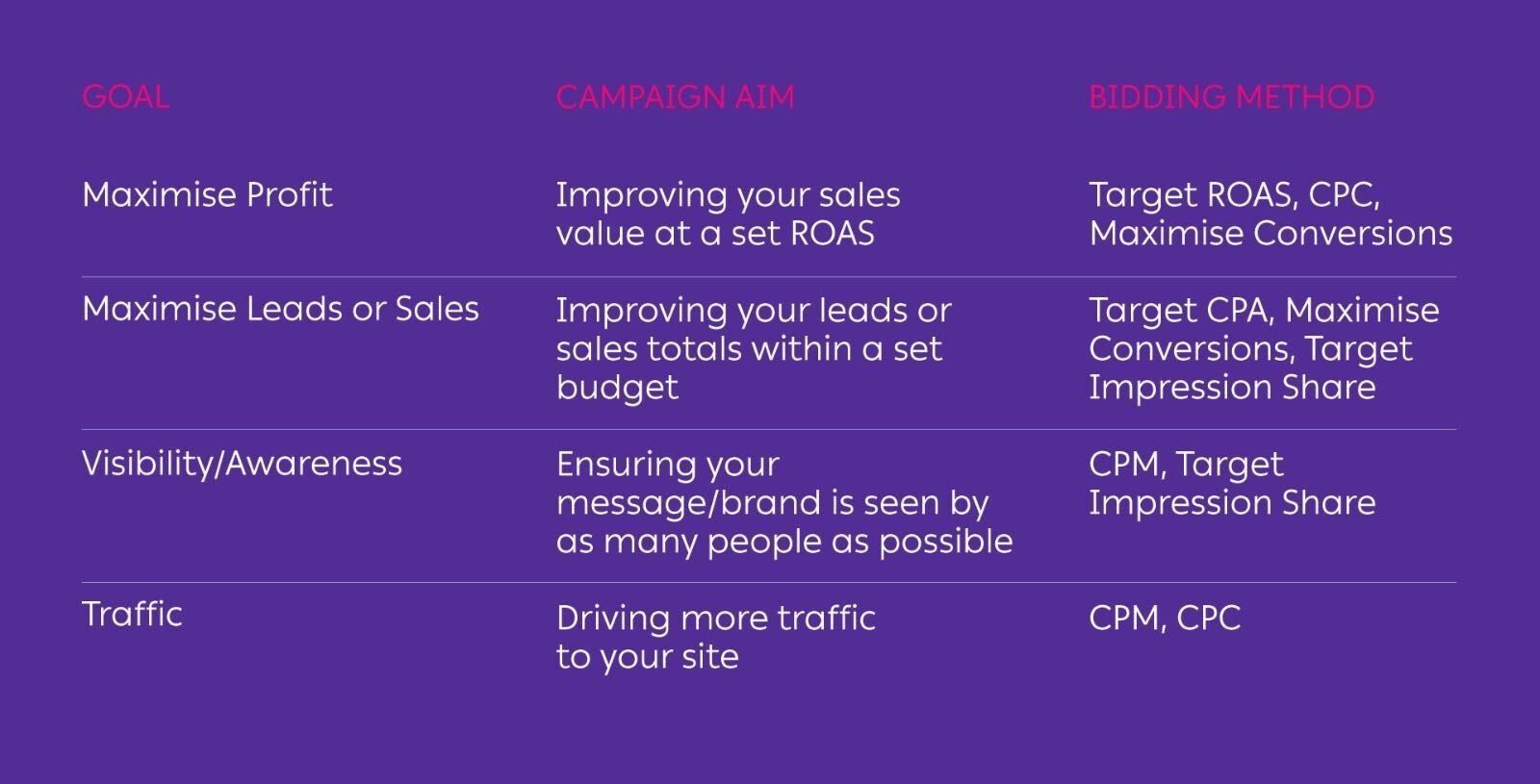A Guide to Understanding PPC Bidding Strategies
Oli Lynch
|Marketing | August 02, 2022

Pay-per-click (PPC) is a huge market, with around $106.5 billion spent worldwide on multiple ad platforms. The biggest by far is Google Ads (previously known as Google Adwords), with over 73% of the global market share.
Facebook and Microsoft (aka Bing) make up the next biggest players, but the roster of available PPC platforms and networks is pretty long. All of them have a whole variety of bidding strategies to help you get the best out of your marketing efforts.
You might need to use a different PPC bid strategy for Google Ads compared to, say, Facebook or Outbrain/Taboola.
So what are the types of PPC bidding strategies available, and which is the best choice for your marketing strategy?
Bid Strategy Options
By definition, a bidding strategy is how your money is used to display your PPC ads. How you choose a bidding strategy depends on a number of factors including the platform, the actual ad itself, your marketing goal and your budget.
There is a selection of standard manual and automated bidding options on most of the ad platforms. These are:
- CPC (also known as eCPC)
- CPM
- Target CPA
- Target ROAS
- Maximize Conversions
- Target Impression Share
Not every ad platform will offer all of these as an option. For example, Google Ads bid strategies will offer the whole range. But, the options for bidding strategies on Instagram or Linkedin for example will be simpler, usually focusing on the simpler CPC or CPM options.
OK, we know jargon and acronyms can be confusing, so we’ll take a deeper look at the definitions of these bid strategy terms.
CPC: Cost Per Click
This is where you pay for each individual click on your ads, which is one of the original and most popular bidding strategies. In fact, there is a choice of options when it comes to pay per click.
- Manual CPC
- Automated CPC
- Enhanced CPC (eCPC)
Using the manual option means you have full control over your ad bids. This can be useful if you’ve done your research and you want to bid high on certain keywords, for example.
As the original PPC bid strategy, manual cost per click is the one that most people think of when they think of PPC.
However, there is a school of thought that manual PPC bidding is redundant. With optional add-ons like Enhanced CPC (eCPC), you can use a sort of smart bidding algorithm. eCPC, for example, will adjust your bids and can even go beyond your maximum CPC if it thinks it can make a difference to your ranking.
This might mean you get a better ranking in the paid SERPs, which can be great. However, that doesn’t necessarily mean you’ll get more conversions.
So you could end up paying more per click but not getting the ROAS as you’d hope.
However, if you have keywords that perform well, and you’re happy to let the Bing, Facebook, or Google bid strategy work out what’s best, you could be in luck.
Another option is Automated CPC. Using this bid strategy allows you to set a daily budget, and then the bidding algorithms do the rest. This does mean you can end up bidding high on certain bids if that’s what the ad platform figures you should do.
In short, a fully manual CPC might not be necessary unless you particularly want to.
|
Pros |
Cons |
|
|
CPM: Cost per Mille
Also known as cost per thousand impressions, the mille is Latin for thousand (although it’s often referred to as cost per mile). This works well on visual display ad campaigns, such as banners, videos, or promoted content.
Generally, if your marketing goal is brand awareness or a similar goal that doesn’t rely heavily on clicks and sales, CPM might be your best bidding strategy choice.
Ads on social media such as Facebook and Instagram are a good example of where you’ll use CPM more often than not. Also, if you’re using a native advertising strategy, CPM is an effective bid strategy to get your ad seen more times for less.
The benefits of CPM are that you can often pay a lower price to display your ad to a wider audience.
If you create a good CPM ad campaign and you get lots of clicks, you could be paying significantly less than if you pay per click.
However, there is no guarantee that you’ll get any clicks, let alone conversions. So, you could end up with your ad seen a thousand (or more) times with zero engagement. However, as a cost-effective way to get your ad seen, it’s a good choice.
A big problem with using CPM as a bid strategy is the potential for fraudulent engagement. Most of the big click fraud and ad fraud campaigns have focused on CPM ads, which is worth bearing in mind.
| Pros | Cons |
|
|
Target CPA: Cost per Acquisition
This is one of the automated bidding options used by Google, Facebook, and Microsoft Ads. With target CPA, the ad platform will aim to get you new leads or customers at the specified target price.
It might sound like this is a great bid strategy for guaranteed conversions, but it doesn’t quite work like that. Most platforms, such as Google and Microsoft, will measure an acquisition as a successful engagement, such as downloading an ebook or filling in a form.
Yes, if someone clicks your ad but doesn’t perform a ‘conversion’ action, you don’t pay. But optimizing your ads for successful conversions is usually quite different from ads optimized for clicks or impressions.
We’re looking at proper BOFU (bottom of the funnel) positioning here, so using CPA to bid on Google or Microsoft Ads means a solid understanding of your market and what will drive conversions.
As a bid strategy to convert, it usually comes with a higher cost than many of the other PPC options.
| Pros | Cons |
|
|
Target ROAS: Return on Ad Spend
If you’ve been running online ad campaigns for a while, you can use this PPC bidding strategy with your most successful keywords. This bid strategy for Google Ads and Microsoft uses data from your past campaigns to predict your return on investment.
Because it uses historical data, you’ll probably already know which keywords work best for you, so switching to ROAS can make sense. Of course, you’ll need to have been using Conversion Tracking, so this works best for sales or other conversion-based bid strategies (as opposed to CPM).
Target ROAS bidding in Google is actually quite a flexible strategy, allowing you to target single or multiple campaigns.
In the case of Google, using Target ROAS for bidding will allow Google to do some clever things such as:
- Adjust your maximum cost per click (CPC)
- Work out the best time to bid for the best chances of conversions
- Aim for a conversion rate (as specified by you)
Google will usually suggest a total ROAS value for a specific campaign, based on performance data from the past few weeks.
| Pros | Cons |
|
|
Maximize Clicks/Conversions
This automated bid strategy aims to get the most bang for your buck, literally. Set your budget, and Google Ads, Microsoft, etc, will try and get you as many clicks or conversions as possible for that price. Again, this is based on historical data, so you will need to have a PPC campaign that has been running for at least a few weeks.
What’s the difference between Target ROAS and Maximise Clicks?
Using the Maximise Clicks bid strategy means you’ll get as many clicks as possible, which doesn’t necessarily mean conversions or sales. It’s perfect for when you’re trying to maximize the amount of site visitors, perhaps to check out some new information or boost traffic.
You can limit your maximum cost per click, specify your daily budget and let the ad platform handle the rest.
| Pros | Cons |
|
|
Target Impression Share
This relatively new automated bidding strategy for Google Ads can be a useful way to get your ad seen. Advertisers can set their target percentage and their budget and then choose how they want their impressions to be seen.
The positioning choices are:
- Top of page
- Absolute top of page
- Anywhere on the page
Google then adjusts your bids to ensure you get your chosen position as often as possible for your budget.
When is this useful?
With your ad positioned right, you’ll have the potential to get plenty of clicks or views on your ad for a set price. As always, nothing is guaranteed with regards to conversions or clicks, but it is a cost-effective way to get your ad on the top.
| Pros | Cons |
|
|
Choosing the right bidding strategy for your goals
As we’ve seen here, there are benefits and risks with every risk strategy. And the strategy you choose will depend mostly on your ad strategy in general.
Of course, there is nothing stopping you from using each of these PPC bid strategies on a variety of ad campaigns. And, with the automated bid options, it can be easy to set it up and see what happens.
Of course, the success of your PPC ads depends on many things, including:
- Your keyword research
- The platform you’re using
- Your budget and bid amount
- The quality of your ad
- Demographic targeting
- Your industry and market situation
To confuse matters further, each web advertising platform has its own way of doing things and managing bid strategies.
Google and Microsoft Advertising offer pretty much the whole selection we’ve discussed here. Facebook bidding strategies will be slightly less complex, and sites like Linkedin or Twitter will offer a more simple selection such as CPC or CPM.
Assuming you’re looking at Google Ads bidding strategies, this simple guide will help you choose the right one.
Pay-per-click best practice
Whatever web advertising platform you’re using, keep an eye on your KPIs to ensure your bid strategy is working as it should.
This includes checking your analytics daily, especially for large-scale campaigns.
Although pay-per-click is a huge industry, offering a massive global reach, it’s worth remembering that all of the ad platforms are open to fraud. In fact, over 90% of all PPC campaigns are defrauded in some manner, usually via invalid clicks.
These invalid clicks can come from genuine accidents from site visitors clicking the wrong link, or they can be a result of automated bots or organized criminals. Click fraud is a $20 billion industry and is growing every year.
Protect your pay-per-click ad campaigns from this fraudulent practice, whichever platform you’re using.
CHEQ is the only GTMSec suite that covers all of the major advertising platforms, including Google, Microsoft, Facebook, LinkedIn, and more.
Secure your GTM goals today Click here to Request a Demo.













